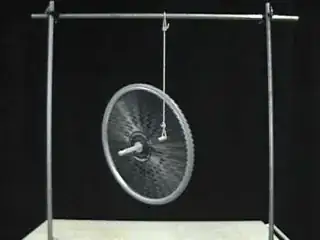About deriving precession rate from the model presented in the answer you wrote
I recommend starting with dividing the wheel in four quadrants. What happens in the top half is symmetric to what happens in the bottom half, and what happens in the leading half is symmetric to what happens in the trailing half. Concentrating on a quadrant reduces complexity, and once you have worked out one quadrant you have in effect worked out all four quadrants.
Let's say we do the quadrant that is part of the top half and part of the leading half.
As you moving along the length of that quadrant, starting at the top:
We are looking at the velocity component in the direction parallel to the horizontal. As you move along the rim from top point to the leading point: the velocity component in the horizontal direction becomes ever slower. The magnitude of that velocity component (as a function of position along the rim) can be expressed mathematically.
The magnitude of the torque as you move along the rim (from top point to leading point) is proportional to the height above the height of the hub. So you can express the magnitude of the torque as a function of position along the rim.
But it's not clear how to integrate the effects along the rim of the wheel to a resultant effect. Neither the magnitude nor the direction of the effect is uniform along the rim.
There's an additional problem. When a wheel is in precessing motion there are transient internal stresses the entire time.
Here is an argument to make the existence of those internal stresses plausible.
I assume you have seen the skill of swinging around a piece of pizza dough, and throwing into the air. You never see any precessing motion. The reason for that is: dough is flexible, so any internal bending forces immediately bend the dough, and the energy is dissipated.
In order to display sustained precessing motion a body must be quite rigid.
The only way to derive the rate of precession, it seems to me, is to find a way such that it isn't necessary to express the force at every point along the rim.
A way must be found such that the forces of internal stresses drop out of the calculation. Or better still: to do what existing derivations do: set up such that the forces of internal stresses do not enter the calculation in the first place.
Here I need to discuss the following: if it is assumed the wheel is rigid isn't it the case that the internal stresses drop out of the calculation automatically?
I think they don't drop out automatically. It may be that an internal stress shifts a force to another part of the wheel where it has either less or more leverage.
If you try the strategy I outlined above (writing a mathematical expressing for the force at every point along the rim) and it doesn't work out, then I think that's due to not taking internal stresses into account.
